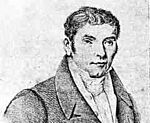Henri Braconnot facts for kids
Quick facts for kids
Henri Braconnot
|
|
|---|---|

Henri Braconnot
|
|
| Born | 29 May 1780 Commercy, France
|
| Died | 13 January 1855 (aged 74) |
| Nationality | French |
| Known for | discovered chitin and pectin |
| Scientific career | |
| Fields | Chemistry, Pharmacy |
Henri Braconnot (born May 29, 1780 – died January 13, 1855) was an important French chemist and pharmacist. He made many discoveries about plants and other natural substances. His work helped us understand more about chemistry and even led to new inventions.
Contents
Early Life and Education
Henri Braconnot was born in Commercy, France. His father was a lawyer. When Henri was only seven years old, his father passed away.
He started school in Commercy. Later, he had private teachers. At 13, he began learning about pharmacy in Nancy. There, he studied pharmacy, chemistry, and botany (the study of plants).
When he was 15, he joined the military. He worked in a hospital in Strasbourg. This experience helped him learn even more.
In 1801 and 1802, Henri lived in Paris. He attended many schools and lectures. He learned from famous scientists like Antoine François, comte de Fourcroy and Jean-Baptiste Lamarck. During this time, he also did some chemical research. He studied the makeup of a fossil horn.
Career in Nancy
In 1802, Henri Braconnot moved back to Nancy. He stayed there for the rest of his life. In 1807, he became the director of the botanical garden in Nancy. He also joined the city's scientific academy.
He spent his career as a chemist. He mostly focused on the chemistry of plants. He researched how plants take in nutrients. He also studied organic acids, what plants are made of, and fats. He even made small contributions to mineralogy (the study of minerals) and hydrology (the study of water).
In 1823, he became a member of the Académie des Sciences in Paris. This was a great honor. By the time he died in 1855, he had published 112 scientific papers.
Discoveries in Chemistry
Henri Braconnot made many important discoveries. His work helped shape modern chemistry.
Understanding Fats
In 1815, Braconnot studied fats. He found that fats have two main parts. One part is solid, which he called "absolute tallow." The other part is oily, which he called "absolute oil." The firmness of a fat depends on how much of each part it has.
He pressed fats when they were cold. This separated the solid and oily parts. He also found a solid substance after treating fats with chemicals. This substance was similar to "adipocire," which another chemist had found earlier.
Braconnot realized that the "absolute tallow" from beef or sheep could be used to make candles. He called this substance "céromimène," meaning "wax-like." In 1818, he and a pharmacist named Simonin F patented a way to make candles. Later, another chemist, Chevreul, patented an improved method using stearic acid.
Plant Chemistry Breakthroughs
Braconnot was very active in plant chemistry. He found and described several compounds. Many of these were later found to be mixtures of simpler things.
- Acids for Photography: In 1818, he discovered gallic and ellagic acids. He also found pyrogallic acid, also known as pyrogallol. This acid was very important. It later helped in the development of photography.
- Chitin: In 1811, he discovered chitin in mushrooms. Chitin is a type of polysaccharide. This was the earliest known discovery of a polysaccharide. Polysaccharides are complex carbohydrates.
- Making Sugar from Wood: In 1819, Braconnot showed something amazing. He could turn wood, straw, or cotton into a sugar. He did this by treating them with sulfuric acid. Twenty-four years later, the name glucose was given to a similar sugar. This sugar was made from starch, cellulose, or honey.
- Amino Acids: Using the same acid process, Braconnot got a "gelatin sugar" from gelatin. This substance is now called glycine. He also found leucine in muscle fibers. Glycine and leucine are types of amino acids. They are the building blocks of proteins.
- First Man-Made Plastic: Braconnot also reacted concentrated nitric acid with wood or cotton. This created a flammable product called xyloïdine. Xyloïdine was a precursor to collodion and nitrocellulose. It could be turned into a clear, glass-like varnish. This substance is considered the first polymer or plastic material made by a chemist.
- Pectin: In 1825, he discovered pectin. Pectin is a type of heteropolysaccharide. It is found in fruits and is used to make jams and jellies thick.
Braconnot's work greatly advanced our understanding of organic chemistry. He helped lay the groundwork for many future discoveries.
See also
 In Spanish: Henri Braconnot para niños
In Spanish: Henri Braconnot para niños

